Gawrych George W. The 1973 Arab-Israeli War: The Albatross of Decisive Victory (Leavenworth Papers No.21)
Подождите немного. Документ загружается.

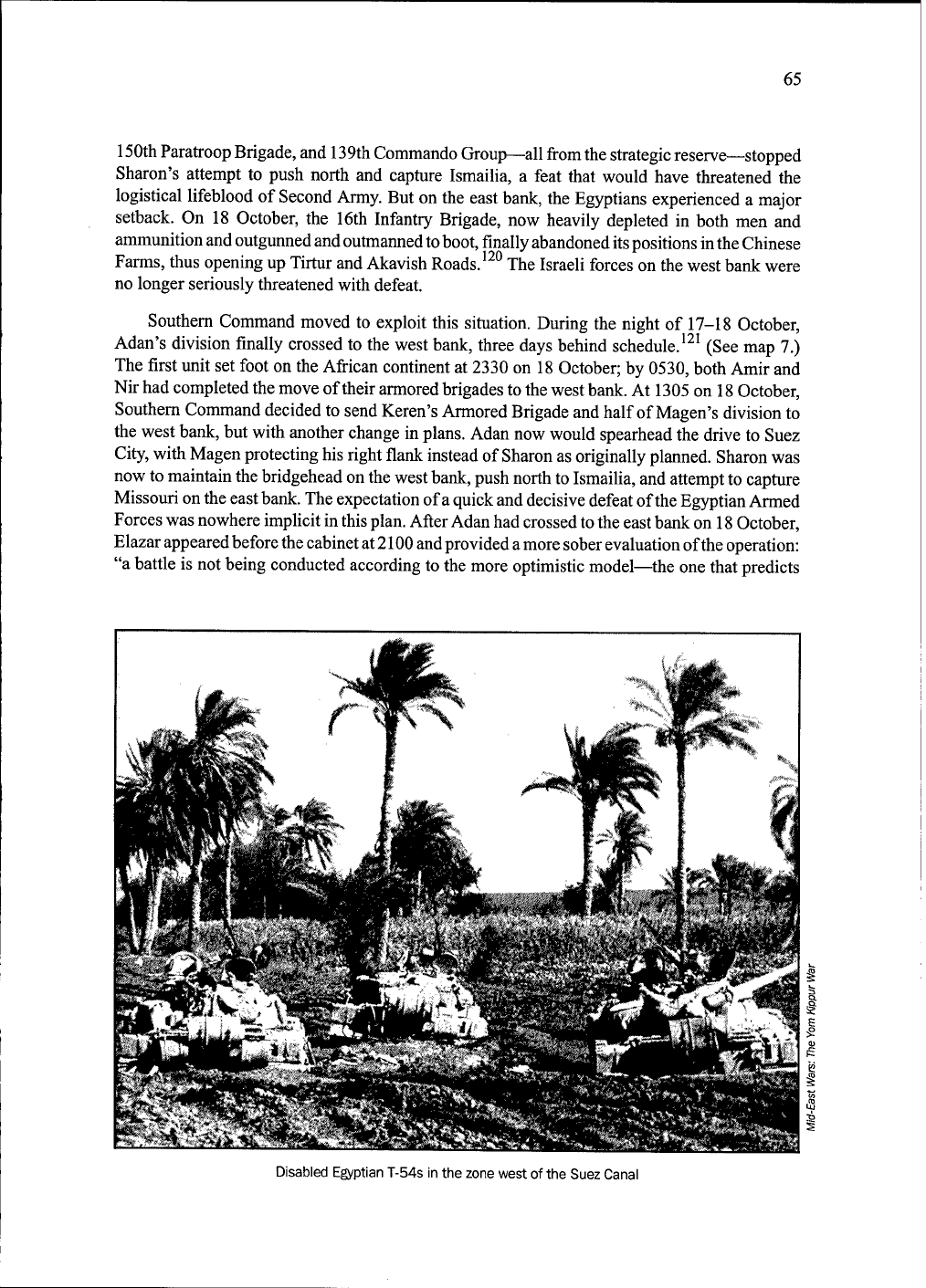
65
150th
Paratroop
Brigade,
and
139th
Commando
Group—all
from
the
strategic
reserve—stopped
Sharon's
attempt
to
push
north
and
capture
Ismailia,
a
feat
that
would
have
threatened
the
logistical
lifeblood
of
Second
Army.
But
on
the
east
bank,
the
Egyptians
experienced
a
major
setback.
On
18
October,
the
16th
Infantry
Brigade,
now
heavily
depleted
in
both
men
and
ammunition
and
outgunned
and
outmanned
to
boot,
finally
abandoned
its
positions
in
the
Chinese
Farms,
thus
opening
up
Tirtur
and
Akavish
Roads.
1
20
The
Israeli
forces
on
the
west
bank
were
no
longer
seriously
threatened
with
defeat.
Southern
Command
moved
to
exploit
this
situation.
During
the
night
of
17-18
October,
Adan's
division
finally
crossed
to
the
west
bank,
three
days
behind
schedule.
1
21
(See
map
7.)
The
first
unit
set
foot
on
the
African
continent
at
2330
on
18
October;
by
0530,
both
Amir
and
Nir
had
completed
the
move
of
their
armored
brigades
to
the
west
bank.
At
1305
on
18
October,
Southern
Command
decided
to
send
Keren's
Armored
Brigade
and
half
of
Magen's
division
to
the
west
bank,
but
with
another
change
in
plans.
Adan
now
would
spearhead
the
drive
to
Suez
City,
with
Magen
protecting
his
right
flank
instead
of
Sharon
as
originally
planned.
Sharon
was
now
to
maintain
the
bridgehead
on
the
west
bank,
push
north
to
Ismailia,
and
attempt
to
capture
Missouri
on
the
east
bank.
The
expectation
of
a
quick
and
decisive
defeat
of
the
Egyptian
Armed
Forces
was
nowhere
implicit
in
this
plan.
After
Adan
had
crossed
to
the
east
bank
on
18
October,
Elazar
appeared
before
the
cabinet
at
2100
and
provided
a
more
sober
evaluation
of
the
operation:
"a
battle
is
not
being
conducted
according
to
the
more
optimistic
model—the
one
that
predicts
Disabled
Egyptian
T-54s
in
the
zone
west
of
the
Suez
Canal

66
MEDITERRANEAN
SEA
Port
Said
c
(0
Of
N
t
(0
1
3
1
C0
!
.
Qantara
Ismailia
xx
I
1H
J
J
>
X
Romani
)
V?
if
Adan-
Moves
soufh
14-
15
October
Knf
Passes
through
(l?
corridor
and
i%
i
bridgehead
t
i
he/diby
/
Sharon
^
Ta?a
C
0
flsM'H
i
«'
,wfl,
'
Bir
Gifgafa
Magen
■
gGREAPS
BITTER
LAKE
Sharon-Opens
corridor,
\
secures
bridgehead,
A:
.,
and
installs
bridg'e%'\
3%
Crosses
behind
"sm-
ft
Adan
Adan
>
P)
Giddi
Pasö*
*
lex
H
Maejen
Suez?
MitlaPass
Note:
Numbers
indicate
sequence
of
movement.
GULF
OF
i
SUEZ
10
",>
20km
—L
__l
Map
7.
Sinai
front,
Operation
Plan
Gazelle

67
.
/
T»
<
If*
.V*
II
Israelis
moving
to
cross
the
canal
on
17
October
Israeli
tanks
crossing
a
pontoon
bridge
onto
the
canal's
west
bank
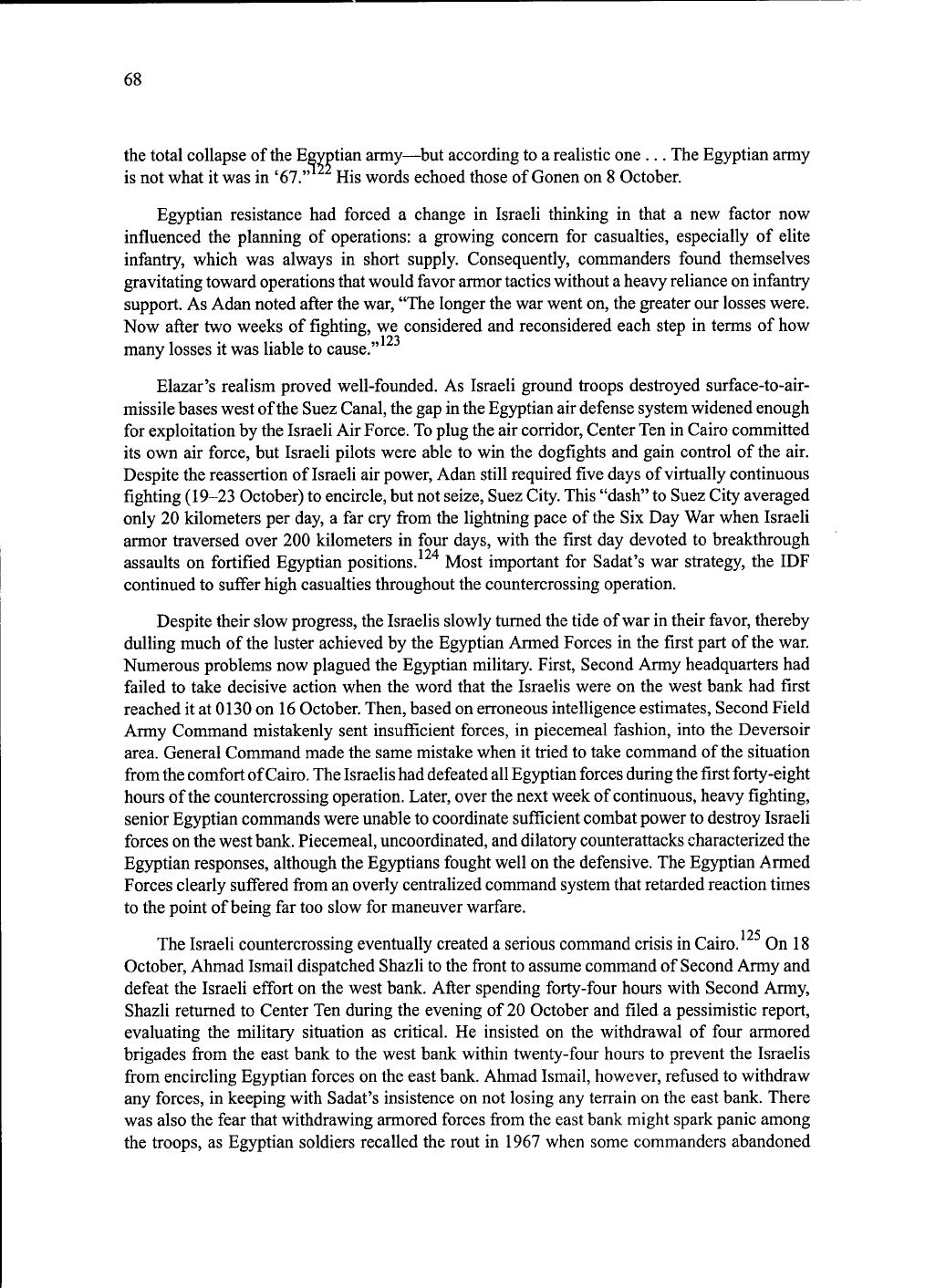
68
the
total
collapse
of
the
Egyptian
army—but
according
to
a
realistic
one
...
The
Egyptian
army
is
not
what
it
was
in
'67."
His
words
echoed
those
of
Gonen
on
8
October.
Egyptian
resistance
had
forced
a
change
in
Israeli
thinking
in
that
a
new
factor
now
influenced
the
planning
of
operations:
a
growing
concern
for
casualties,
especially
of
elite
infantry,
which
was
always
in
short
supply.
Consequently,
commanders
found
themselves
gravitating
toward
operations
that
would
favor
armor
tactics
without
a
heavy
reliance
on
infantry
support.
As
Adan
noted
after
the
war,
"The
longer
the
war
went
on,
the
greater
our
losses
were.
Now
after
two
weeks
of
fighting,
we
considered
and
reconsidered
each
step
in
terms
of
how
many
losses
it
was
liable
to
cause."
Elazar's
realism
proved
well-founded.
As
Israeli
ground
troops
destroyed
surface-to-air-
missile
bases
west
of
the
Suez
Canal,
the
gap
in
the
Egyptian
air
defense
system
widened
enough
for
exploitation
by
the
Israeli
Air
Force.
To
plug
the
air
corridor,
Center
Ten
in
Cairo
committed
its
own
air
force,
but
Israeli
pilots
were
able
to
win
the
dogfights
and
gain
control
of
the
air.
Despite
the
reassertion
of
Israeli
air
power,
Adan
still
required
five
days
of
virtually
continuous
fighting
(19-23
October)
to
encircle,
but
not
seize,
Suez
City.
This
"dash"
to
Suez
City
averaged
only
20
kilometers
per
day,
a
far
cry
from
the
lightning
pace
of
the
Six
Day
War
when
Israeli
armor
traversed
over
200
kilometers
in
four
days,
with
the
first
day
devoted
to
breakthrough
assaults
on
fortified
Egyptian
positions.
Most
important
for
Sadat's
war
strategy,
the
IDF
continued
to
suffer
high
casualties
throughout
the
countercrossing
operation.
Despite
their
slow
progress,
the
Israelis
slowly
turned
the
tide
of
war
in
their
favor,
thereby
dulling
much
of
the
luster
achieved
by
the
Egyptian
Armed
Forces
in
the
first
part
of
the
war.
Numerous
problems
now
plagued
the
Egyptian
military.
First,
Second
Army
headquarters
had
failed
to
take
decisive
action
when
the
word
that
the
Israelis
were
on
the
west
bank
had
first
reached
it
at
0130
on
16
October.
Then,
based
on
erroneous
intelligence
estimates,
Second
Field
Army
Command
mistakenly
sent
insufficient
forces,
in
piecemeal
fashion,
into
the
Deversoir
area.
General
Command
made
the
same
mistake
when
it
tried
to
take
command
of
the
situation
from
the
comfort
of
Cairo.
The
Israelis
had
defeated
all
Egyptian
forces
during
the
first
forty-eight
hours
of
the
countercrossing
operation.
Later,
over
the
next
week
of
continuous,
heavy
fighting,
senior
Egyptian
commands
were
unable
to
coordinate
sufficient
combat
power
to
destroy
Israeli
forces
on
the
west
bank.
Piecemeal,
uncoordinated,
and
dilatory
counterattacks
characterized
the
Egyptian
responses,
although
the
Egyptians
fought
well
on
the
defensive.
The
Egyptian
Armed
Forces
clearly
suffered
from
an
overly
centralized
command
system
that
retarded
reaction
times
to
the
point
of
being
far
too
slow
for
maneuver
warfare.
125
The
Israeli
countercrossing
eventually
created
a
serious
command
crisis
in
Cairo.
On
18
October,
Ahmad
Ismail
dispatched
Shazli
to
the
front
to
assume
command
of
Second
Army
and
defeat
the
Israeli
effort
on
the
west
bank.
After
spending
forty-four
hours
with
Second
Army,
Shazli
returned
to
Center
Ten
during
the
evening
of
20
October
and
filed
a
pessimistic
report,
evaluating
the
military
situation
as
critical.
He
insisted
on
the
withdrawal
of
four
armored
brigades
from
the
east
bank
to
the
west
bank
within
twenty-four
hours
to
prevent
the
Israelis
from
encircling
Egyptian
forces
on
the
east
bank.
Ahmad
Ismail,
however,
refused
to
withdraw
any
forces,
in
keeping
with
Sadat's
insistence
on
not
losing
any
terrain
on
the
east
bank.
There
was
also
the
fear
that
withdrawing
armored
forces
from
the
east
bank
might
spark
panic
among
the
troops,
as
Egyptian
soldiers
recalled
the
rout
in
1967
when
some
commanders
abandoned
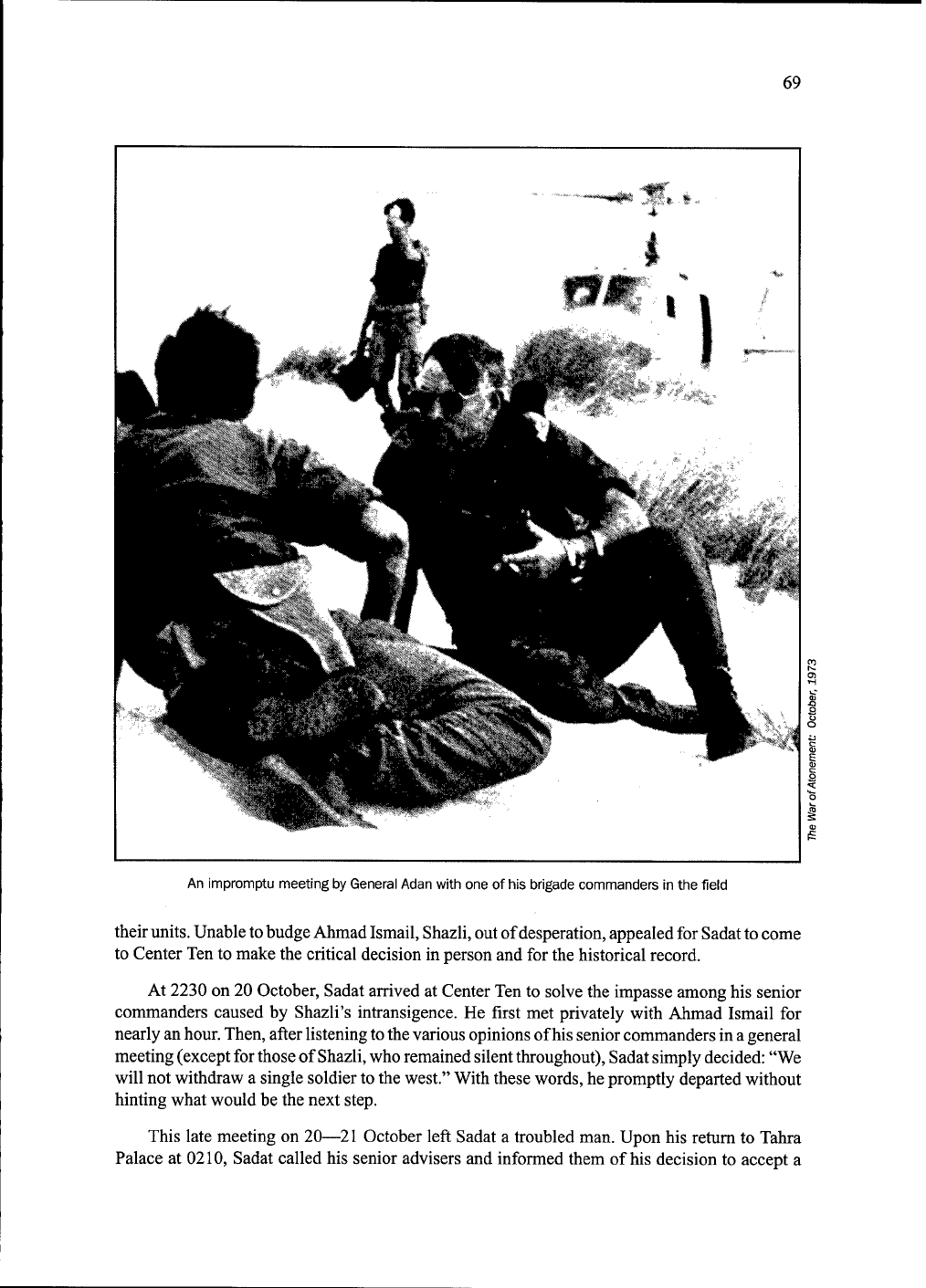
69
An
impromptu
meeting
by
General
Adan
with
one
of
his
brigade
commanders
in
the
field
their
units.
Unable
to
budge
Ahmad
Ismail,
Shazli,
out
of
desperation,
appealed
for
Sadat
to
come
to
Center
Ten
to
make
the
critical
decision
in
person
and
for
the
historical
record.
At
2230
on
20
October,
Sadat
arrived
at
Center
Ten
to
solve
the
impasse
among
his
senior
commanders
caused
by
Shazli's
intransigence.
He
first
met
privately
with
Ahmad
Ismail
for
nearly
an
hour.
Then,
after
listening
to
the
various
opinions
of
his
senior
commanders
in
a
general
meeting
(except
for
those
of
Shazli,
who
remained
silent
throughout),
Sadat
simply
decided:
"We
will
not
withdraw
a
single
soldier
to
the
west."
With
these
words,
he
promptly
departed
without
hinting
what
would
be
the
next
step.
This
late
meeting
on
20—21
October
left
Sadat
a
troubled
man.
Upon
his
return
to
Tahra
Palace
at
0210,
Sadat
called
his
senior
advisers
and
informed
them
of
his
decision
to
accept
a

70
Israeli
medical
teams
in
life-saving
operations
cease-fire
in
place.
Asked
for
an
explanation
for
his
sudden
change
in
strategy,
Sadat
described
how
his
trip
to
Center
Ten
had
convinced
him
that
the
country
and
the
armed
forces
were
in
grave
peril,
and
the
only
option
was
to
seek
a
cessation
of
hostilities
with
the
help
of
both
superpow-
ers.
Sadat,
now
shaken
in
confidence,
clearly
placed
his
hope
squarely
on
the
diplomatic
front.

71
He
had
expected
to
be
in
a
favorable
military
posture
at
the
end
of
hostilities,
but
now,
he
believed,
his
army
faced
a
possible
collapse
reminiscent
of
the
Six
Day
War.
THE
ENDING
OF
HOSTILITIES.
Fortunately
for
Sadat,
events
outside
his
control
helped
save
his
Third
Army
from
collapse.
Soviet
pressures
and
the
Arab
oil
embargo,
when
combined
with
Israel's
military
ascendancy
over
both
Egypt
and
Syria,
convinced
the
Nixon
administration
to
launch
a
diplomatic
offensive.
By
the
end
of
the
war,
the
United
States
had
committed
itself
to
work
for
peace
in
the
Arab-Israeli
conflict.
As
Egypt's
and
Syria's
fortunes
declined
on
the
battlefield,
other
Arab
states
moved
to
help
their
brethren.
On
17
October,
the
Arab
oil-producing
states
raised
the
price
of
oil
70
percent,
announced
a
5
percent
cut
in
production,
and
threatened
to
reduce
output
5
percent
every
month
until
Israel
withdrew
from
territories
seized
in
the
Six
Day
War.
On
18
October,
the
Saudi
government
announced
a
10
percent
cut
in
output.
When,
on
19
October,
Nixon
formally
requested
from
Congress
a
$2.2
billion
emergency
aid
package
for
Israel,
Saudi
Arabia
retaliated
the
next
day
by
placing
an
oil
embargo
on
the
United
States;
other
Arab
states
quickly
followed
Riyadh's
lead.
The
military
struggle
between
the
Arabs
and
Israelis
now
took
the
added
form
of
economic
warfare,
which
shook
stock
markets
around
the
world
and
heightened
concerns
in
western
Europe
and
Japan.
The
Nixon
administration,
although
besieged
by
the
Watergate
scandal,
felt
pressured
to
take
center
stage
in
an
effort
to
bring
a
cease-fire
to
the
conflict.
Kissinger,
who
had
been
waiting
for
the
right
moment
to
intervene
with
a
major
diplomatic
initiative,
began
what
evolved
into
a
step-by-step
process.
While
continuing
to
provide
massive
military
aid
to
Israel
(begun
on
13
October),
Washing-
ton
now
moved
on
the
diplomatic
front
to
assume
the
role
of
honest
broker.
The
United
States
stood
as
the
only
power
capable
of
forcing
Israel
to
cease
offensive
operations
against
Egypt.
On
19
October,
Kissinger
accepted
a
Soviet
invitation
to
visit
Moscow
to
discuss
bringing
hostilities
to
an
end.
He
departed
the
day
before
the
Saudis
announced
their
oil
embargo.
It
was
in
this
context
that
Sadat
went
to
Center
Ten
late
on
20
October
to
meet
with
his
senior
commanders,
knowing
that
both
superpowers
were
moving
to
bring
about
an
end
to
the
armed
conflict.
Hoping
for
a
diplomatic
breakthrough,
the
Egyptian
president
desperately
wanted
to
keep
all
his
gains
on
the
east
bank
and
thus
remained
adamant
on
not
withdrawing
any
forces
from
the
east
to
the
west
bank.
Meanwhile,
in
discussions
at
the
Kremlin
on
21
October,
the
Americans
and
Soviets
agreed
to
sponsor
a
United
Nations
resolution
for
a
cease-fire
to
commence
on
22
October
at
1820.
Before
returning
to
the
United
States,
Kissinger
visited
Tel
Aviv
on
22
October
to
meet
personally
with
Golda
Meir
and
discuss
the
terms
of
the
cease-fire.
Soviet
Premier
Aleksei
Kosygin
meanwhile
traveled
to
Cairo
to
confer
with
Sadat.
Both
Egypt
and
Israel
agreed
to
a
cease-fire
in
place.
7
(See
map
8.)
The
commencement
of
the
cease-fire
on
22
October
at
1820
found
Israeli
forces
north
of
Suez
City,
short
of
surrounding
Third
Army,
though
the
Egyptian
situation
was
becoming
precarious.
Israeli
artillery
fire
could
interdict
the
Suez
to
Cairo
road,
the
main
artery
supplying
the
two
Egyptian
divisions
on
the
east
bank
in
Third
Army's
sector.
But
only
ground
troops
could
effectively
cut
off
Third
Army,
which
required
the
surrounding
of
Suez
City.
Fortunately
for
Israel,
United
Nations
Resolution
338,
which
called
for
a
cease-fire
in
place
(sponsored
by
both
superpowers),
failed
to
provide
for
a
peacekeeping
force
to
supervise
its
implementation.
This
omission
provided
Israel
with
an
opportunity
to
continue
its
advance
southward.
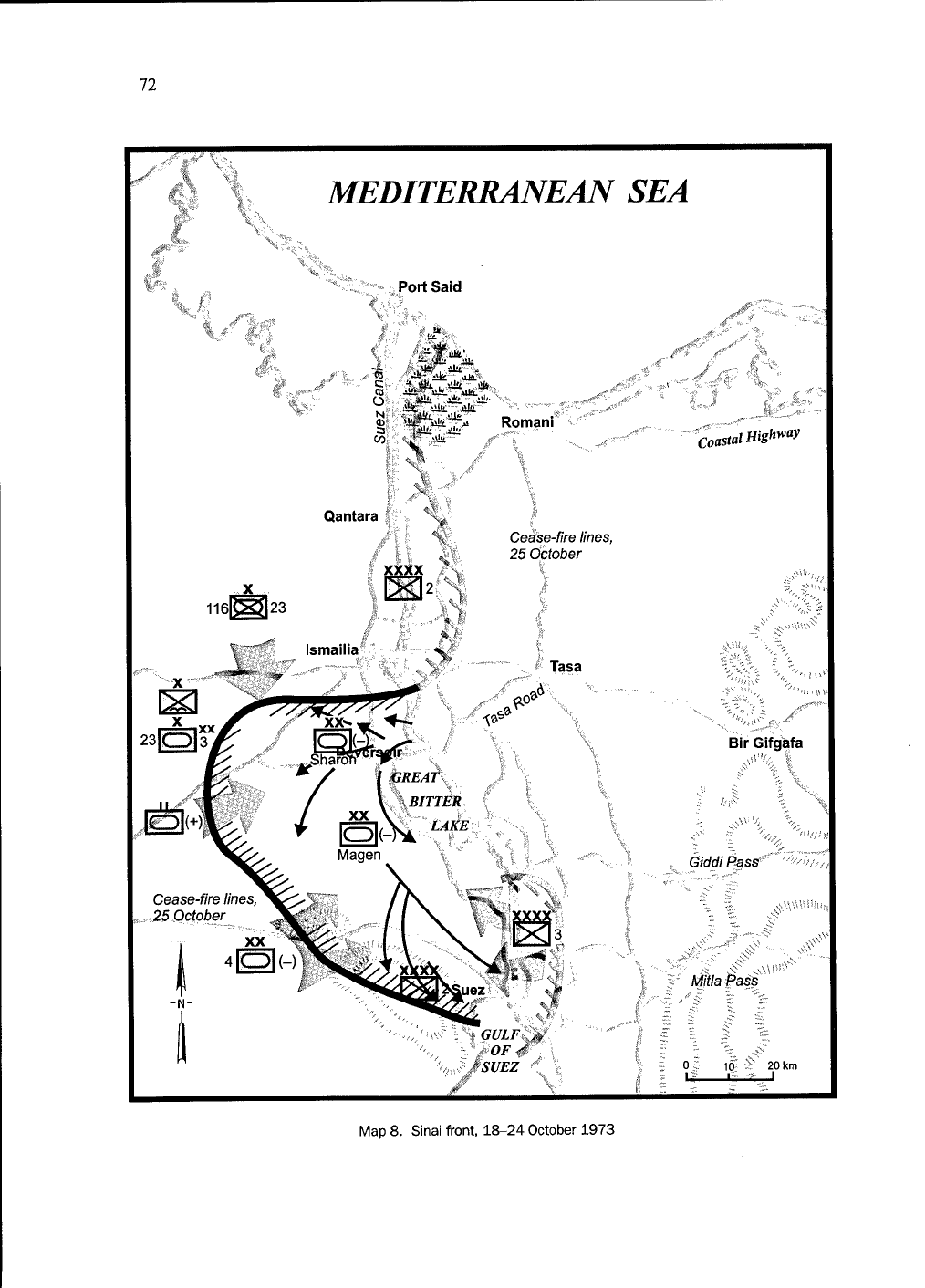
72
MEDITERRANEAN
SEA
Port
Said
gis.w^siri^-»!
Roman
i
Is
.it
/
\
"co»tt/Hte««^
Qantara
Cease-fire
lines,
25
October
Tasa
I
GULF^M.
"ßOF^l
iSUEZ
'
#
Bir
Gifgafa
Giddi
Pass*
Mitia
Pass
0
5
10-
■
£
20
km
I«
I-
"r,
I
Map
8.
Sinai
front,
18-24
October
1973
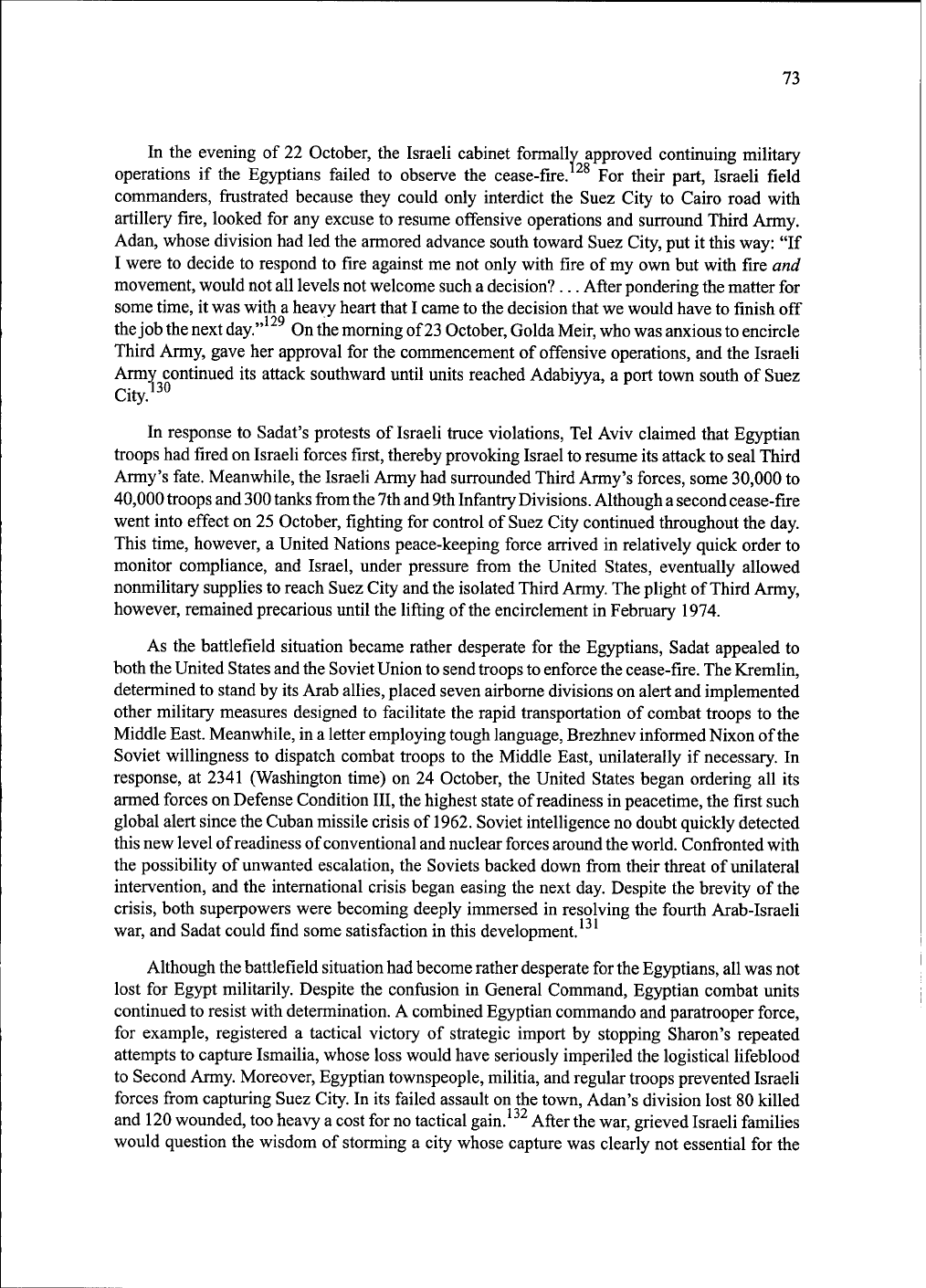
73
In
the
evening
of
22
October,
the
Israeli
cabinet
formally
approved
continuing
military
operations
if
the
Egyptians
failed
to
observe
the
cease-fire.
For
their
part,
Israeli
field
commanders,
frustrated
because
they
could
only
interdict
the
Suez
City
to
Cairo
road
with
artillery
fire,
looked
for
any
excuse
to
resume
offensive
operations
and
surround
Third
Army.
Adan,
whose
division
had
led
the
armored
advance
south
toward
Suez
City,
put
it
this
way:
"If
I
were
to
decide
to
respond
to
fire
against
me
not
only
with
fire
of
my
own
but
with
fire
and
movement,
would
not
all
levels
not
welcome
such
a
decision?...
After
pondering
the
matter
for
some
time,
it
was
with
a
heavy
heart
that
I
came
to
the
decision
that
we
would
have
to
finish
off
129
the
job
the
next
day."
On
the
morning
of
23
October,
Golda
Meir,
who
was
anxious
to
encircle
Third
Army,
gave
her
approval
for
the
commencement
of
offensive
operations,
and
the
Israeli
Army
continued
its
attack
southward
until
units
reached
Adabiyya,
a
port
town
south
of
Suez
City.
1
30
In
response
to
Sadat's
protests
of
Israeli
truce
violations,
Tel
Aviv
claimed
that
Egyptian
troops
had
fired
on
Israeli
forces
first,
thereby
provoking
Israel
to
resume
its
attack
to
seal
Third
Army's
fate.
Meanwhile,
the
Israeli
Army
had
surrounded
Third
Army's
forces,
some
30,000
to
40,000
troops
and
300
tanks
from
the
7th
and
9th
Infantry
Divisions.
Although
a
second
cease-fire
went
into
effect
on
25
October,
fighting
for
control
of
Suez
City
continued
throughout
the
day.
This
time,
however,
a
United
Nations
peace-keeping
force
arrived
in
relatively
quick
order
to
monitor
compliance,
and
Israel,
under
pressure
from
the
United
States,
eventually
allowed
nonmilitary
supplies
to
reach
Suez
City
and
the
isolated
Third
Army.
The
plight
of
Third
Army,
however,
remained
precarious
until
the
lifting
of
the
encirclement
in
February
1974.
As
the
battlefield
situation
became
rather
desperate
for
the
Egyptians,
Sadat
appealed
to
both
the
United
States
and
the
Soviet
Union
to
send
troops
to
enforce
the
cease-fire.
The
Kremlin,
determined
to
stand
by
its
Arab
allies,
placed
seven
airborne
divisions
on
alert
and
implemented
other
military
measures
designed
to
facilitate
the
rapid
transportation
of
combat
troops
to
the
Middle
East.
Meanwhile,
in
a
letter
employing
tough
language,
Brezhnev
informed
Nixon
of
the
Soviet
willingness
to
dispatch
combat
troops
to
the
Middle
East,
unilaterally
if
necessary.
In
response,
at
2341
(Washington
time)
on
24
October,
the
United
States
began
ordering
all
its
armed
forces
on
Defense
Condition
III,
the
highest
state
of
readiness
in
peacetime,
the
first
such
global
alert
since
the
Cuban
missile
crisis
of
1962.
Soviet
intelligence
no
doubt
quickly
detected
this
new
level
of
readiness
of
conventional
and
nuclear
forces
around
the
world.
Confronted
with
the
possibility
of
unwanted
escalation,
the
Soviets
backed
down
from
their
threat
of
unilateral
intervention,
and
the
international
crisis
began
easing
the
next
day.
Despite
the
brevity
of
the
crisis,
both
superpowers
were
becoming
deeply
immersed
in
resolving
the
fourth
Arab-Israeli
war,
and
Sadat
could
find
some
satisfaction
in
this
development.
Although
the
battlefield
situation
had
become
rather
desperate
for
the
Egyptians,
all
was
not
lost
for
Egypt
militarily.
Despite
the
confusion
in
General
Command,
Egyptian
combat
units
continued
to
resist
with
determination.
A
combined
Egyptian
commando
and
paratrooper
force,
for
example,
registered
a
tactical
victory
of
strategic
import
by
stopping
Sharon's
repeated
attempts
to
capture
Ismailia,
whose
loss
would
have
seriously
imperiled
the
logistical
lifeblood
to
Second
Army.
Moreover,
Egyptian
townspeople,
militia,
and
regular
troops
prevented
Israeli
forces
from
capturing
Suez
City.
In
its
failed
assault
on
the
town,
Adan's
division
lost
80
killed
and
120
wounded,
too
heavy
a
cost
for
no
tactical
gain.
After
the
war,
grieved
Israeli
families
would
question
the
wisdom
of
storming
a
city
whose
capture
was
clearly
not
essential
for
the

74
Elk,
■
*•*'
lK~-4
*
■■■
'*
•
-
■
.
.
l"f
i
\kiJ
"*'
«£&?
■
T
'
■■
*
■
'
■
;VVV.>*K;.','v-<:
Israeli
troops
by
the
sweet-water
canal
near
Ismailia
defeat
of
Third
Army.
Moreover,
to
everyone's
surprise,
including
Sadat
and
senior
officers
back
in
Cairo,
surrounded
Egyptian
forces
on
the
east
bank
maintained
their
combat
integrity.
Finally,
and
perhaps
most
important,
Second
Army's
position
remained
secure
on
both
the
east
and
west
banks.
Thus,
the
final
week
of
the
war
offered
more
sobering
combat
experiences
for
Israel,
despite
its
operational
and
tactical
successes,
thereby
undermining
any
chance
of
a
clear
Israeli
strategic
victory.
During
this
last
phase
of
the
war,
the
Egyptian
Armed
Forces
continued
to
inflict
a
heavy
toll
in
Israeli
blood
and
treasure.
In
this
regard,
Egyptian
field
officers
and
line
troops
made
up
for
the
senior
command's
seeming
paralysis
by
fulfilling
Sadat's
strategic
objective
of
inflicting
the
greatest
possible
losses
in
men
and
equipment
on
the
IDF.
Furthermore,
by
clearly
demon-
strating
a
new
combat
staying
power,
the
Egyptian
Armed
Forces
presented
Israel
with
vivid
testimony
that
a
future
conflict
between
Egypt
and
Israel
could
exact
a
heavy
price
in
Jewish
lives.
The
full
impact
of
this
lesson
would
surface
only
after
the
war,
once
the
Israelis
had
time
to
reflect
on
the
conflict.
IMPACT
IN
ISRAEL.
The
1973
war
ended
on
a
high
military
note
for
Israel.
The
IDF
had
recovered
from
its
initial
shock
to
seize
the
initiative
on
both
fronts.
In
the
Sinai,
the
encirclement
of
Suez
City
and
Third
Army
undermined
Sadat's
confidence
and
provided
the
Israeli
government
with
a
strong
bargaining
position
after
the
war.
On
the
Golan
front,
the
Israelis
had
counterattacked
to
regain
all
lost
territory
and
even
penetrated
twenty
kilometers
into
Syria
to
reach
within
forty
kilometers
of
Damascus.
In
light
of
these
Israeli
operational
and
tactical
achievements
on
both
fronts,
many
Western
observers
have
unabashedly
awarded
Israel
a
military
victory
in
1973.
In
contrast,
Israeli
society,
for
the
most
part,
assessed
the
1973
War
in
